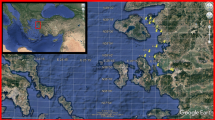Abstract
The metal load into sediments and the change in the sedimentary environment of Osaka Bay in the Seto Inland Sea have been studied through geochemical analysis of core sediments, using both Pb-210 dating and a selective chemical leaching technique. Analytical results from a 6-m core of sediment show that copper and zinc pollution started in the late 1800's and the present enrichment ratios of copper and zinc, relative to background levels (20 mg kg−1 for Cu and 94 mg kg−1 for Zn), are 2.8 and 4.1, respectively. The present anthropogenic copper and zinc loads into Osaka Bay sediments, are 47 and 368 ton yr−1, while natural copper and zinc loads are 40 and 186 ton yr−1, respectively. Osaka Bay sediment at the present day is considered to be seriously polluted by zinc, now. The vertical profiles of copper and zinc in four successively separated fractions (10% acetic acid soluble fraction: F-HAC, 0.1M hydrochloric acid-soluble fraction: F-HCl, hydrogen peroxide-soluble fraction: F-H2O2 and hydrofluoric acid-soluble fraction: F-HF) from the core sediments indicate that enrichments of copper and zinc in the upper layer of the sediment are dependent on increases in the metal contents of the F-HAC, F-HCl and F-H2O2 fractions. Copper in F-HAC, and zinc in F-HAC and F-HCl, seem to be of anthropogenic origin.
Results of sequential studies of the whole Seto Inland Sea can be summarized as follows: At the present time, the sedimentary loads of copper and zinc over the whole Seto Inland Sea area are 630 and 3,500 ton yr−1, respectively, while the natural and anthropogenic loads are 320 and 310 ton yr−1 for copper and 1,800 and 1,700 ton yr−1 for zinc, respectively.
Similar content being viewed by others
References
Fujiwara, T. (1981): Seto naikai ni okeru kaisui koryu. Umi no Kisho,27, 1–19.
Grill, E. V. (1978): The effect of sediment-water exchange on manganese deposition and nodule growth in Jervis Inlet, British Columbia. Geochim. Cosmochim. Acta,42, 485–494.
Higo, T., Y. Takasugi and H. Tanabe (1980): Tidal current in the Seto Inland Sea. Rep. Gov. Ind. Res. Inst., Chugoku,12, 81–120 (in Japanese with English abstract).
Hoshika, A., T. Shiozawa and E. Matsumoto (1983): Sedimentation rates and heavy metal pollution in sediments in Harima-Nada (Harima Sound), Seto Inland Sea. J. Oceanogr. Soc. Japan,39, 51–56 (in Japanese with English abstract).
Hoshika, A. and T. Shiozawa (1984a): Sedimentation rates and heavy metal pollution of sediments in the Seto Inland. Sea, Part 2. Hiroshima Bay, J. Oceanogr. Soc. Japan,40, 115–123.
Hoshika, A. and T. Shiozawa (1984b): Sedimentation rates and heavy metal pollution of sediments in the Seto Inland Sea, Part 3. Hiuchi-Nada, J. Oceanogr, Soc. Japan,40, 334–342.
Hoshika, A. and T. Shiozawa (1985): Sedimentation rates and heavy metal pollution of sediments in the Seto Inland Sea, Part 4. Suho-Nada, J. Oceanogr. Soc. Japan,41, 283–290.
Hoshika, A., T. Shiozawa and Y. Kitano (1986), Manganese, iron, copper and zinc in sediment cores from seasonally-stratified Beppu Bay, the Seto Inland Sea, Japan. In: Urban Wastes in Coastal Marine Environments, Vol. 5, ed. by D. A. Wolfe, Robert E. Krieger pub., Florida. (in press).
Joh, H., S. Yamochi and T. Abe (1974): The condition of heavy metal pollution in Osaka Bay. Bull. Osaka Pref. Fish. Exp. Stat.,4, 4–41.
Kawakami, Y. and H. Nishimura (1976): Benzo(a) pyrene in the sediment and Keihin Canal and its estimated source. J. Oceanogr. Soc. Japan,32, 175–181.
Kato, T. (1938): Hokubu Osaka wan no rikagakuteki kosatsu. Umi to Sora,18, 21–29 (in Japanese).
Kitano, Y. and R. Fujiyoshi (1980): Selective chemical leaching of cadmium, copper, manganese and iron in marine sediments. Geochim. J.,14, 113–122.
Kitano, Y., M. Sakata and E. Matsumoto (1981): Partitioning of heavy metals into mineral and organic fractions in a sediment core sample from Osaka Bay. J. Oceanogr. Soc. Japan,37, 259–266.
Li, Y. H., J. G. Bischoff and G. Mathieu (1969): The migration of manganese in the arctic basin sediment. Earth Planet. Sci. Lett.,7, 265–270.
Lynn, D. C. and E. Bonatti (1965): Mobility of manganese in diagenesis of deep-sea sediments. Mar. Geol.,3, 457–474.
Masuzawa, T. and Y. Kitano (1982): Diagenetic deposition of manganese in sediment of historically meromictic lake, Lake Suigetsu, Japan. J. Oceanogr. Soc. Japan,38, 73–80.
Matsumoto, E. and S. Yokota (1978): Accumulation rate and heavy metal pollution in Osaka Bay sediments. J. Oceanogr. Soc. Japan,34, 108–115 (in Japanese with English abstract).
Nakashima, S. (1982): Partitioning of heavy metals (Mn, Fe. As, Cd, Pb, Cu, Zn, Co and Ni) into selective chemical fractions in sediment cores from lake Biwa. Jap. J. Limnol.,43, 67–80 (in Japanese with English abstract).
Nishimura, H. and M. Kumagaya (1974): Seto naikai no osen. Kagaku,44, 103–109 (in Japanese)
Shiozawa, T., K. Kawana, Y. Yamaoka, A. Hoshika, T. Tanimoto and O. Takimura (1984a): Distribution of pollutant in sea water and its dissolution out of bottom sediment in the Seto Inland Sea. 1. Phosphorous and nitrogen. Rep. Gov. Ind. Res. Inst. Chugoku, Japan,21, 13–43 (in Japanese with English abstract).
Shiozawa, T. K. Kawana, Y. Yamaoka, A. Hoshika, S. Hirata, T. Tanimoto and O. Takimura (1984b): Distribution of pollutant in sea water and its dissolution out of bottom sediment in the Seto Inland Sea. 2. Manganese and iron. Rep. Gov. Ind. Res. Inst. Chugoku, Japan,21, 45–61 (in Japanese with English abstract).
Skei, J. and P. E. Pause (1979): Surface metal enrichment and partitioning of metals in a dated sediment core from a Norwegian fjord. Geochim. Cosmochim. Acta,43, 239–246.
Tanimoto, T., K. Kawana and Y. Yamaoka (1984): Grain size parameters and organic matter of bottom sediment in the Seto Inland Sea. Rep. Gov. Ind. Res. Inst. Chugoku, Japan,21, 1–11 (in Japanese with English abstract).
Uematsu, M. and S. Tsunogai (1983): Recycling of manganese in the coastal sea, Funka Bay, Japan. Mar. Chem.,13, 1–14.
Author information
Authors and Affiliations
Rights and permissions
About this article
Cite this article
Hoshika, A., Shiozawa, T. Heavy metals and accumulation rates of sediments in Osaka Bay, the Seto Inland Sea, Japan. Journal of the Oceanographical Society of Japan 42, 39–52 (1986). https://doi.org/10.1007/BF02109191
Received:
Revised:
Accepted:
Issue Date:
DOI: https://doi.org/10.1007/BF02109191




